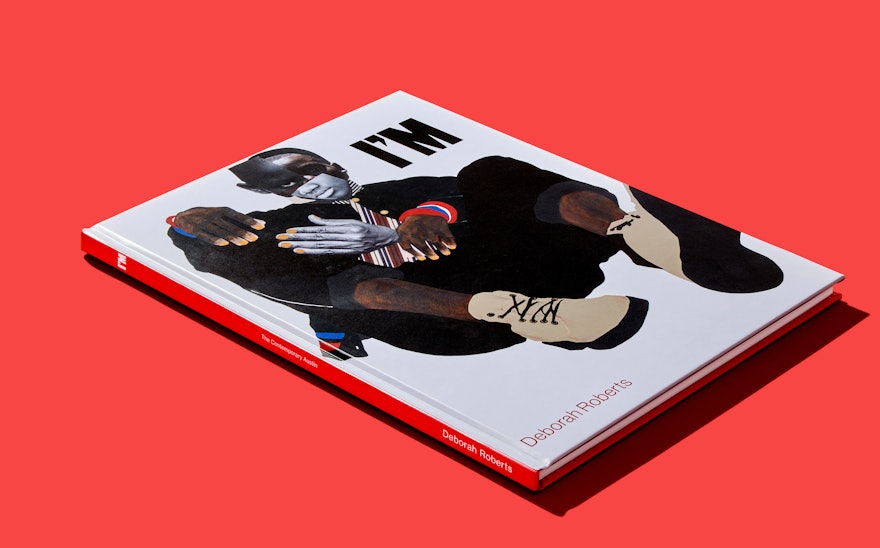Deborah Roberts is one of Austin’s most important modern artists. She has recently caught the eye of top museums and collectors, and last year she was featured in a one-woman show at The Contemporary Austin–her first major exhibition in her hometown. The show, titled I'M, occupied the entire bottom floor of the Jones Center and was a milestone for both the artist and the museum.
DJ Stout and the Pentagram Austin office have enjoyed a long working relationship with The Contemporary Austin since its founding in 2013, having previously designed the museum’s identity and website, and consulted on its naming. Last winter, Pentagram Austin was commissioned to design a coffee-table book and interactive website for Deborah Roberts’ groundbreaking show.
The coffee-table book includes studio shots of Roberts’ artworks by Paul Bardagjy and environmental photographs of her work in the exhibition space by Colin Doyle. There are also essays by Darren Walker, President of the Ford Foundation; Heather Pesanti, Chief Curator and Director of Curatorial Affairs at The Contemporary Austin; Eddie Chambers, Professor of Art History at the University of Texas at Austin; and a Q&A with the artist conducted by Zoé Whitley, Director of Chisenhale Gallery in London.
Roberts has utilized a number of styles and mediums throughout her career, but her collage work has been the most successful, attracting the attention of major museums like the Whitney Museum of American Art, Brooklyn Museum, The Studio Museum in Harlem, Los Angeles Museum of Art, and Blanton Museum of Art.
Some of her early mixed media works contained collaged elements from photographs of African American children, including images of herself as a child. Her early collages were simple, but explored themes of self-worth, identity and racism. As her style evolved, she began to use pencil shading, swaths of paint and pieces of patterned linoleum flooring. The flat, matte swaths of painted canvas and pencil shading, contrasted with the glossy photographic and brightly colored linoleum elements, make for a striking visual that is heightened by the sparse spotlighting of the exhibition at the Jones Center.
The photographic elements of Roberts’ collages incorporate fragments of anonymous faces, hands and other body parts, as well as historically significant Black figures like Barack Obama, Sidney Poitier and James Baldwin. She also often works in larger formats, with her collaged figures ranging from eight to twelve feet tall. Through the perspective of childhood, she addresses complex social, political and racial constructs, and the challenges they present for young black children.
For her Contemporary Austin exhibition, Roberts created twenty-eight mostly new works including paintings, prints, collages, texts and an interactive sculptural installation. Her large-scale collages, mostly of African American children, include a massive outdoor mural titled Little Man, Little Man (named after the 1976 children’s book by James Baldwin) that covers the entire exterior wall of the Jones Center.
The coffee-table book, 11” X 14” with a hard cover, is designed with decidedly extra whitespace and has the luxury of displaying Roberts’ artworks on a larger scale. The size gives the reader the benefit of seeing enhanced details of the collages and provides a good approximation of the experience of viewing Roberts’ large-scale canvases at the museum.
The typographic styling of the book features a distinct typeface called “Martin”, by Vocal Type, which is used for the main title of the exhibition and other display type in the book. The typeface is based on the bold, sans-serif letterforms printed on the placards carried by protesters during the historic Memphis sanitation workers strike of 1968.
The protest was sparked by a horrific incident where two Black city employees died while riding in the back of a trash truck to escape a torrential rain. The men had been forced to work through the storm that had drenched the city for several days and during their ride home, the compactor was accidentally triggered and they were crushed to death. This landmark protest in the streets of Memphis led to the assassination of Martin Luther King.
The sanitation workers marched in the streets with signs bearing the stark, heart-wrenching declaration “I AM A MAN.” Given the personal racial themes of Deborah Roberts’ work and the title of her book I’M (or I AM), the design team felt that the use of the “Martin” typeface was not only appropriate, but symbolic of the artist’s powerful body of work.
In addition, Pentagram Austin was commissioned to design the special online exhibition website, deborahrobertsim.org. The microsite, also titled “I’M,” takes the viewer on an immersive, virtual tour of the show featuring additional information and images, excerpts from the book, a filmed presentation by the Contemporary’s Chief Curator Heather Pesanti and audio of Deborah Roberts speaking about her art and motivations.
Deborah Roberts I'M moved to the Museum of Contemporary Art Denver in September 2021, and is currently on view until January 30, 2022.

